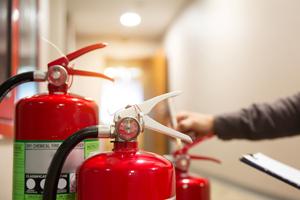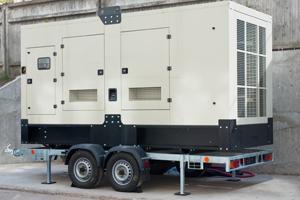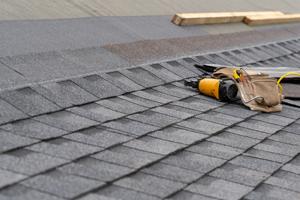Quick safety inspections reference guide

Workplace inspections are designed to ensure written procedures are being followed, workers are trained and to identify deficiencies that need attention. Inspections should be conducted by employees who are familiar with the exposures and hazards that are found in their workplace or working locations. This form is designed as a sample of a form that can be used to remind designated persons when certain inspections should take place. Not all OSHA inspection requirements are included in this form and the hazards and standards that are found or apply to your workplace may differ. Your state or local authority may have standards, rules, requirements which are more stringent.
Daily |
Yes/No |
|---|---|
| Safety orientation provided to all new workers | |
| Vehicles and other powered equipment inspected and controls work | |
| PPE is used by workers based on exposure(s) | |
| Workers wash hands before eating, drinking, smoking | |
| Housekeeping maintained to control slipping, tripping, and fire hazards | |
| Procedures followed for lockout/tagout, confined space, and work at heights | |
| Exit signs are visible and clear for emergency egress | |
| Exterior walkways maintained to control slipping and tripping hazards |
Monthly |
Yes/No |
|---|---|
| Fire extinguishers inspected — charged, property located, and a accessible | |
| First aid kits are maintained and located in designated areas | |
| Emergency eyewash stations are maintained and clean | |
| Loading dock truck locks/wheel trucks are used and in good condition | |
| Electrical cords (temporary) and tools are in good condition | |
| Equipment and machine guards are in place and working/used properly | |
| Hot work/confined space permits used and filed | |
| Illumination adequate in all walking/working areas | |
| Approved safety cans used and flammable liquids stored properly | |
| Facility ventilation system functioning properly | |
| Forklifts properly shut down when not attended | |
| Washrooms kept clean and sanitary |
Quarterly |
Yes/No |
|---|---|
| Carbon monoxide testing conducted when required (fueled powered forklifts) | |
| Safety data sheets available in designated area | |
| Labels maintained on all temporary containers | |
| Electrical connections (conduit, covers) tight with no openings in electrical panels or outlets | |
| Gas welding/cutting equipment in good condition (hoses, torches, gauges) | |
| Gas cylinders properly stored and secured with caps in place | |
| Accident reports maintained and completed in a timely manner |
Annually |
Yes/No |
|---|---|
| Lockout/tagout inspection by authorized employees | |
| Fire extinguisher maintenance check conducted | |
| Evacuation drill conducted, alarm systems tested | |
| Fire extinguisher training conducted | |
| Eye wash stations inspected and within expiration date | |
| Hazard communication training conducted | |
| Bloodborne pathogen/CPR training conducted for first responders | |
| Safety program goals updated (reference OSHA 300 log, accident investigations, workplace inspection findings) | |
| OSHA 300 log updated, signed and posted (Feb — April) | |
| Annual refresher training conducted on exposures of high severity | |
| Annual exhaust test of forklifts when required | |
| Stairway treads maintaining slip resistance | |
| New operations reviewed for hazards, PPE requirements, training | |
| Personal fall protection equipment inspected by Competent Person |
This material is provided for informational purposes only and does not provide any coverage or guarantee loss prevention. The examples in this material are provided as hypothetical and for illustration purposes only. The Hanover Insurance Company and its affiliates and subsidiaries (“The Hanover”) specifically disclaim any warranty or representation that acceptance of any recommendations contained herein will make any premises, or operation safe or in compliance with any law or regulation. By providing this information to you, The Hanover does not assume (and specifically disclaims) any duty, undertaking or responsibility to you. The decision to accept or implement any recommendation(s) or advice contained in this material must be made by you.
LC JAN 2019 12‐228
171-1021 (02/14)
Related resources
Quick safety inspections reference guide
Workplace inspections are designed to ensure written procedures are being followed, workers are trained and to identify deficiencies that need attention. Inspections should be conducted by employees who are familiar with the exposures and hazards that are found in their workplace or working locations. This form is designed as a sample of a form that can be used to remind designated persons when certain inspections should take place. Not all OSHA inspection requirements are included in this form and the hazards and standards that are found or apply to your workplace may differ. Your state or local authority may have standards, rules, requirements which are more stringent.
Daily |
Yes/No |
|---|---|
| Safety orientation provided to all new workers | |
| Vehicles and other powered equipment inspected and controls work | |
| PPE is used by workers based on exposure(s) | |
| Workers wash hands before eating, drinking, smoking | |
| Housekeeping maintained to control slipping, tripping, and fire hazards | |
| Procedures followed for lockout/tagout, confined space, and work at heights | |
| Exit signs are visible and clear for emergency egress | |
| Exterior walkways maintained to control slipping and tripping hazards |
Monthly |
Yes/No |
|---|---|
| Fire extinguishers inspected — charged, property located, and a accessible | |
| First aid kits are maintained and located in designated areas | |
| Emergency eyewash stations are maintained and clean | |
| Loading dock truck locks/wheel trucks are used and in good condition | |
| Electrical cords (temporary) and tools are in good condition | |
| Equipment and machine guards are in place and working/used properly | |
| Hot work/confined space permits used and filed | |
| Illumination adequate in all walking/working areas | |
| Approved safety cans used and flammable liquids stored properly | |
| Facility ventilation system functioning properly | |
| Forklifts properly shut down when not attended | |
| Washrooms kept clean and sanitary |
Quarterly |
Yes/No |
|---|---|
| Carbon monoxide testing conducted when required (fueled powered forklifts) | |
| Safety data sheets available in designated area | |
| Labels maintained on all temporary containers | |
| Electrical connections (conduit, covers) tight with no openings in electrical panels or outlets | |
| Gas welding/cutting equipment in good condition (hoses, torches, gauges) | |
| Gas cylinders properly stored and secured with caps in place | |
| Accident reports maintained and completed in a timely manner |
Annually |
Yes/No |
|---|---|
| Lockout/tagout inspection by authorized employees | |
| Fire extinguisher maintenance check conducted | |
| Evacuation drill conducted, alarm systems tested | |
| Fire extinguisher training conducted | |
| Eye wash stations inspected and within expiration date | |
| Hazard communication training conducted | |
| Bloodborne pathogen/CPR training conducted for first responders | |
| Safety program goals updated (reference OSHA 300 log, accident investigations, workplace inspection findings) | |
| OSHA 300 log updated, signed and posted (Feb — April) | |
| Annual refresher training conducted on exposures of high severity | |
| Annual exhaust test of forklifts when required | |
| Stairway treads maintaining slip resistance | |
| New operations reviewed for hazards, PPE requirements, training | |
| Personal fall protection equipment inspected by Competent Person |
This material is provided for informational purposes only and does not provide any coverage or guarantee loss prevention. The examples in this material are provided as hypothetical and for illustration purposes only. The Hanover Insurance Company and its affiliates and subsidiaries (“The Hanover”) specifically disclaim any warranty or representation that acceptance of any recommendations contained herein will make any premises, or operation safe or in compliance with any law or regulation. By providing this information to you, The Hanover does not assume (and specifically disclaims) any duty, undertaking or responsibility to you. The decision to accept or implement any recommendation(s) or advice contained in this material must be made by you.
LC JAN 2019 12‐228
171-1021 (02/14)
Related resources
Quick safety inspections reference guide
Workplace inspections are designed to ensure written procedures are being followed, workers are trained and to identify deficiencies that need attention. Inspections should be conducted by employees who are familiar with the exposures and hazards that are found in their workplace or working locations. This form is designed as a sample of a form that can be used to remind designated persons when certain inspections should take place. Not all OSHA inspection requirements are included in this form and the hazards and standards that are found or apply to your workplace may differ. Your state or local authority may have standards, rules, requirements which are more stringent.
Daily |
Yes/No |
|---|---|
| Safety orientation provided to all new workers | |
| Vehicles and other powered equipment inspected and controls work | |
| PPE is used by workers based on exposure(s) | |
| Workers wash hands before eating, drinking, smoking | |
| Housekeeping maintained to control slipping, tripping, and fire hazards | |
| Procedures followed for lockout/tagout, confined space, and work at heights | |
| Exit signs are visible and clear for emergency egress | |
| Exterior walkways maintained to control slipping and tripping hazards |
Monthly |
Yes/No |
|---|---|
| Fire extinguishers inspected — charged, property located, and a accessible | |
| First aid kits are maintained and located in designated areas | |
| Emergency eyewash stations are maintained and clean | |
| Loading dock truck locks/wheel trucks are used and in good condition | |
| Electrical cords (temporary) and tools are in good condition | |
| Equipment and machine guards are in place and working/used properly | |
| Hot work/confined space permits used and filed | |
| Illumination adequate in all walking/working areas | |
| Approved safety cans used and flammable liquids stored properly | |
| Facility ventilation system functioning properly | |
| Forklifts properly shut down when not attended | |
| Washrooms kept clean and sanitary |
Quarterly |
Yes/No |
|---|---|
| Carbon monoxide testing conducted when required (fueled powered forklifts) | |
| Safety data sheets available in designated area | |
| Labels maintained on all temporary containers | |
| Electrical connections (conduit, covers) tight with no openings in electrical panels or outlets | |
| Gas welding/cutting equipment in good condition (hoses, torches, gauges) | |
| Gas cylinders properly stored and secured with caps in place | |
| Accident reports maintained and completed in a timely manner |
Annually |
Yes/No |
|---|---|
| Lockout/tagout inspection by authorized employees | |
| Fire extinguisher maintenance check conducted | |
| Evacuation drill conducted, alarm systems tested | |
| Fire extinguisher training conducted | |
| Eye wash stations inspected and within expiration date | |
| Hazard communication training conducted | |
| Bloodborne pathogen/CPR training conducted for first responders | |
| Safety program goals updated (reference OSHA 300 log, accident investigations, workplace inspection findings) | |
| OSHA 300 log updated, signed and posted (Feb — April) | |
| Annual refresher training conducted on exposures of high severity | |
| Annual exhaust test of forklifts when required | |
| Stairway treads maintaining slip resistance | |
| New operations reviewed for hazards, PPE requirements, training | |
| Personal fall protection equipment inspected by Competent Person |
This material is provided for informational purposes only and does not provide any coverage or guarantee loss prevention. The examples in this material are provided as hypothetical and for illustration purposes only. The Hanover Insurance Company and its affiliates and subsidiaries (“The Hanover”) specifically disclaim any warranty or representation that acceptance of any recommendations contained herein will make any premises, or operation safe or in compliance with any law or regulation. By providing this information to you, The Hanover does not assume (and specifically disclaims) any duty, undertaking or responsibility to you. The decision to accept or implement any recommendation(s) or advice contained in this material must be made by you.
LC JAN 2019 12‐228
171-1021 (02/14)
Related resources
Quick safety inspections reference guide
Workplace inspections are designed to ensure written procedures are being followed, workers are trained and to identify deficiencies that need attention. Inspections should be conducted by employees who are familiar with the exposures and hazards that are found in their workplace or working locations. This form is designed as a sample of a form that can be used to remind designated persons when certain inspections should take place. Not all OSHA inspection requirements are included in this form and the hazards and standards that are found or apply to your workplace may differ. Your state or local authority may have standards, rules, requirements which are more stringent.
Daily |
Yes/No |
|---|---|
| Safety orientation provided to all new workers | |
| Vehicles and other powered equipment inspected and controls work | |
| PPE is used by workers based on exposure(s) | |
| Workers wash hands before eating, drinking, smoking | |
| Housekeeping maintained to control slipping, tripping, and fire hazards | |
| Procedures followed for lockout/tagout, confined space, and work at heights | |
| Exit signs are visible and clear for emergency egress | |
| Exterior walkways maintained to control slipping and tripping hazards |
Monthly |
Yes/No |
|---|---|
| Fire extinguishers inspected — charged, property located, and a accessible | |
| First aid kits are maintained and located in designated areas | |
| Emergency eyewash stations are maintained and clean | |
| Loading dock truck locks/wheel trucks are used and in good condition | |
| Electrical cords (temporary) and tools are in good condition | |
| Equipment and machine guards are in place and working/used properly | |
| Hot work/confined space permits used and filed | |
| Illumination adequate in all walking/working areas | |
| Approved safety cans used and flammable liquids stored properly | |
| Facility ventilation system functioning properly | |
| Forklifts properly shut down when not attended | |
| Washrooms kept clean and sanitary |
Quarterly |
Yes/No |
|---|---|
| Carbon monoxide testing conducted when required (fueled powered forklifts) | |
| Safety data sheets available in designated area | |
| Labels maintained on all temporary containers | |
| Electrical connections (conduit, covers) tight with no openings in electrical panels or outlets | |
| Gas welding/cutting equipment in good condition (hoses, torches, gauges) | |
| Gas cylinders properly stored and secured with caps in place | |
| Accident reports maintained and completed in a timely manner |
Annually |
Yes/No |
|---|---|
| Lockout/tagout inspection by authorized employees | |
| Fire extinguisher maintenance check conducted | |
| Evacuation drill conducted, alarm systems tested | |
| Fire extinguisher training conducted | |
| Eye wash stations inspected and within expiration date | |
| Hazard communication training conducted | |
| Bloodborne pathogen/CPR training conducted for first responders | |
| Safety program goals updated (reference OSHA 300 log, accident investigations, workplace inspection findings) | |
| OSHA 300 log updated, signed and posted (Feb — April) | |
| Annual refresher training conducted on exposures of high severity | |
| Annual exhaust test of forklifts when required | |
| Stairway treads maintaining slip resistance | |
| New operations reviewed for hazards, PPE requirements, training | |
| Personal fall protection equipment inspected by Competent Person |
This material is provided for informational purposes only and does not provide any coverage or guarantee loss prevention. The examples in this material are provided as hypothetical and for illustration purposes only. The Hanover Insurance Company and its affiliates and subsidiaries (“The Hanover”) specifically disclaim any warranty or representation that acceptance of any recommendations contained herein will make any premises, or operation safe or in compliance with any law or regulation. By providing this information to you, The Hanover does not assume (and specifically disclaims) any duty, undertaking or responsibility to you. The decision to accept or implement any recommendation(s) or advice contained in this material must be made by you.
LC JAN 2019 12‐228
171-1021 (02/14)





